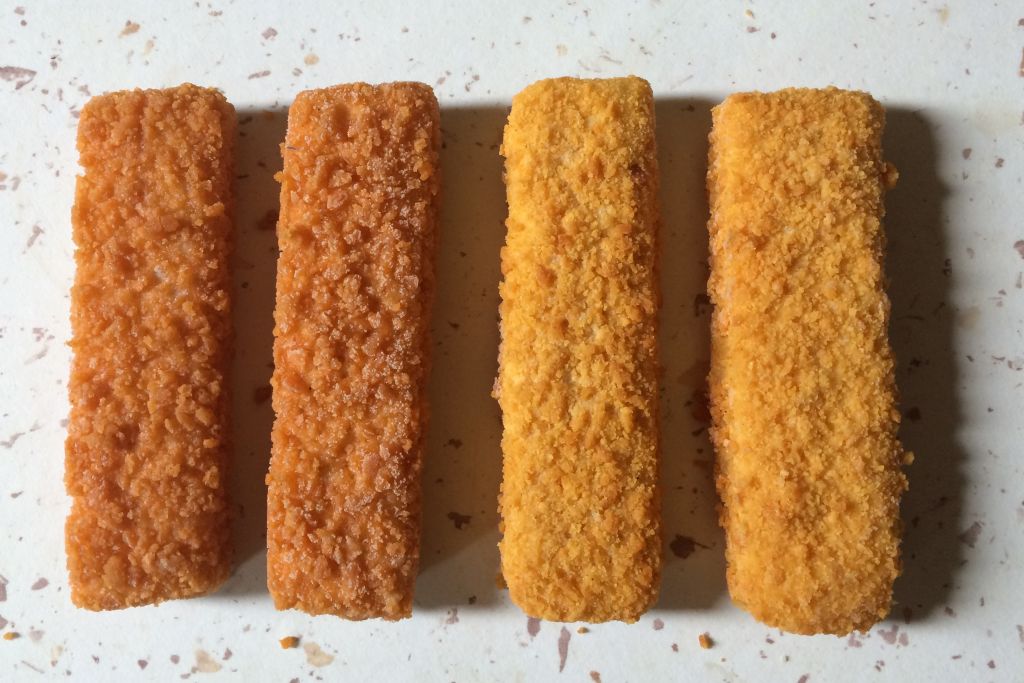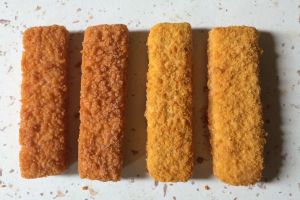Zap the Vap: One of the plenary speakers at Aquaculture Europe 2016 was Ally Dingwall, aquaculture and fisheries manager at Sainsbury’s supermarket who presented a retailers’ perspective. Both Fishupdate and Undercurrent News reported on this talk but what caught our attention was a picture taken of one of the slides used to illustrate the presentation. The slide was titled ‘Broadening repertoire’ and shows Sainsbury’s ‘Switch the Fish’ campaign.
We, at Callander McDowell have previously discussed ‘Switch the Fish’ on both the occasions that the supermarket ran the promotion. The idea was that when a customer bought one of the Big 5 – cod, haddock, salmon, tuna and prawns, they would be offered a portion of one of five lesser known species. The campaign was deemed to be a success, but we were not so convinced. In our opinion, Sainsbury’s supermarket fish counters are still dominated by the Big 5 and the lesser consumed species remain in the background. British consumers still prefer the Big 5 and we don’t see that this is really an issue since at least they are eating these fish.
The reports of Ally Dingwall’s presentation don’t mention why he showed the slide about Switch the Fish but what he did say was that he could see a time when there is a shift away from added value back to the primary fish protein. He told the audience that he was imagining what would happen as the planet tries to feed a growing population. As demand increases, prices will rise and this will make VAP increasingly unattractive.
He said that we need to grow more fish to meet any shortfall but there are currently no plans to do this. However, as Ally pointed out, current consumption is also falling short of the recommended two 140g portions of fish a week. He said that consumption currently stands at about 20.8kg per person per year, which means that every person is consuming at least 12kg of fish less than they should be. We, at Callander McDowell, wonder whether it might be even more than this, since the data shows that home consumption of fish is in rapid decline.
If Ally Dingwall’s figure are correct, the UK requires an extra 760,000 tonnes of fish to feed the UK population and this will have to come from aquaculture. However, this aspiration for all UK citizens to eat two portions of fish a week is unlikely to be met. It’s a nice idea but we suspect that it is just unrealistic. This is because if we are failing to meet targets now, it can only get worse as, or if, the population continues to expand.
We believe that this is because we are giving consumers the wrong message about fish. We only need to look at the Switch the Fish campaign. This says we should move off the Big 5 and try other species but if the consumer is happy eating the Big Five we should simply rejoice that they are eating fish at all. It’s not as if the Big 5 are not certified or responsibly produced.
Equally, many consumers buy fish because it is available in convenient form usually as VAP. They like VAP because they don’t like the raw protein. If the future trend is a movement away from VAP, we could see an increasing movement away from fish altogether.
Edinburgh Aquaculture Salute: Fishupdate.com reports that the Scottish Minister for Aquaculture, Fergus Ewing, stressed the importance of aquaculture to Scotland when he officially opened the European Aquaculture Society’s Aquaculture Europe 16 conference in Edinburgh. He said that the Government works together with the industry and academia in a modern triumvirate which was the reason he was delighted to welcome the EAS to Edinburgh for the first time having chosen to hold their meeting in Scotland.
Mr Ewing might see that there is a triumvirate but we, at Callander McDowell think that someone at Aquaculture Europe missed a trick. Our principal made a short visit to the meeting and was disappointed by what he saw. The programme, which was very scientific and academic did not seem to have a Scottish theme but rather a range of subjects covering the international aquaculture arena. Aquaculture might be important to Scotland but we would suggest that if anyone had visited from the Scottish aquaculture industry they may have felt somewhat out of place.
There were people from the industry in attendance in Edinburgh but in most part they were there to take part in some of the industry and trade meetings that took place in parallel. However, if they hadn’t been invited, they probably wouldn’t have even known they were happening.
In our view, one whole day should have been devoted to Scottish aquaculture both with regard to the industry and to science. The Minister said that Scottish aquaculture presents many challenges and this meeting would have been an ideal opportunity to consider these challenges in more detail, attracting not only the scientists but also the industry. This would have been the occasion to bring the two together as well as with Government. Unfortunately, it was an opportunity missed.
Philanthropic: Mark Zukerberg of Facebook fame has just announced that he is donating $3 billion in an attempt to end human disease. Whether this is attainable is unknown but it is a very noble attempt. In the same week, the Walton family, of Walmart fame, have announced they will donate $250 million to marine conservation. Together with pledges from the David and Lucile Packard Foundation and the Gordon and Betty Moore Foundation, more than $1 billion will be set aside for marine conservation and research.
Seafood Source say that the Walton family have long supported marine conservation and this new money will help with six different strategies. These are:
Development of scientific information
Empowering local fishermen
Safeguarding critical habitats
Help rebuild fisheries
Promote fisheries policies and programs
Harness the market for sustainable seafood.
However well-intentioned these donations, there is a niggling concern that perhaps these Foundations are trying to mould the marine environment in their vision, which may or may not be the same as that of others. History gives some support to this concern.
Some years ago, Canadian, Vivian Krause brought to the attention of the salmon farming industry that some of these charitable foundations were investing millions in swaying the market in the US against farmed salmon and towards locally caught wild salmon. Ultimately, these attempts failed and consumers won but how do we know whether the Foundations are influencing the way marine conservation is being undertaken and whether it is right for the marine environment? At least when Government’s form environmental policy the voters can get a say.
The attempt to sway the US market away from farmed salmon will form part of a presentation to be given at the Humber Seafood Summit next week by our Dr Martin Jaffa who will speak about what consumers think of farmed fish.
A load of pollocks: Intrafish have highlighted that Lidl in Germany have heralded a new era in the battle between retail brands and own label with a campaign that hopes to lure consumers with competitive prices without any compromise on quality. Lidl have compared their own brand Ocean Sea fish fingers against Iglo’s branded fish fingers.
According to Intrafish, the new campaign has caused some consternation in the US because they say that the two products are not comparable. The Lidl’s Pollock fish fingers are likely to be double frozen from China or single frozen from Russia whilst Iglo’s pollock is likely to be single frozen and caught around Alaska.
Both packs name the fish as Alaska pollock but since 2015, a law in the US has required fish that are named Alaska pollock must come from Alaska. Intrafish point out that in Germany, such a requirement would be confusing since pollock in German refers to another species of fish.
In a separate editorial, Intrafish propose a simple solution to this confusion. They say that the fish should be named in relation to origin so pollock caught around Alaska would still be known as Alaskan pollock but fish caught in Russian waters should be called Russian pollock and so on. This would not only minimise confusion but would also help those companies that have taken to promote Alaskan pollock from Alaska on the front of their packaging.
There is one line in the editorial that caught our eye and that is the editor says that he thinks that both US and European consumers don’t really care what fish is in their meal but they increasingly do care as to where and how it was caught. It is this claim that forms much of the basis of Lidl’s campaign.
We, at Callander McDowell, are not so convinced. We would argue that at the price points filled by Alaskan pollock, most consumers are unlikely to be interested in where or how the fish was caught. At the bottom end of this market, they are also less likely to be concerned as to which fish they are eating but what is clear is that in the UK, the wider fish finger market is changing showing that many consumers do care about which fish is in their fingers.
Alaskan pollock came to the UK following environmental concerns that the North Sea cod fishery had collapsed and consumers were told that cod was off the menu. Alaskan pollock was widely available and an ideal replacement and was cheaper too. Soon, Alaskan pollock was been used as a substitute in most frozen coated products. In an attempt to differentiate Alaskan pollock in the fish finger market, Bird’s Eye launched omega 3 fish fingers containing Alaskan pollock, even though the omega 3 content was minimal compared to the amount found in oily fish species.
Alaskan pollock dominated the market for a number of years. Most products didn’t highlight the species with the name only appearing in the ingredients list. However, the resurgence of North Sea cod means cod is back on the menu and there has been a rush to replace Alaskan pollock with cod and to a lesser extent haddock. Alaskan pollock is losing ground in the UK frozen sector and as a result, products are either being reduced in price or discounted.
Whether the fish actually comes from Alaska or Russia is totally irrelevant as whether it has been frozen once or twice or even what theta means. The consumer is more interested in price. Certainly, if it were priced against cod, most UK consumers would simply opt for cod. Even the omega 3 story appears to be flagging. Perhaps, consumers have found that the omega 3 level is not sufficiently high to make a difference to their child’s intelligence.
As for the name, UK suppliers are already ahead of the game. Increasingly, pollock is being named on the ingredient list as Pacific pollock thus negating in one swoop any concerns about the exact origin of the fish. The same change is also appearing on wild salmon where the Alaskan name is being dropped in favour of Pacific salmon.
Finally, is there any difference between Lidl’s and Iglo’s offering? Both packs are available in the UK. Iglo’s product, which is manufactured in Germany, appears under the Bird’s Eye label. Lidl’s Ocean Sea fish fingers are also manufactured in Germany and are available in the UK too. Clearly, the best way to judge the difference between them is to taste them.
We bought Ocean Sea 15 fish fingers from Lidl 450g £1.29 £2.86/kg and Bird’s Eye 12 Omega 3 fish fingers 336g £1.00 £2.97/kg. Bird’s Eye appear to have dropped their standard Alaska Pollock fish fingers and thus the only one available with Alaska pollock are the Omega 3 variant. These were available at a discount of 67p making them only 10p/kg more expensive than the Lidl version.
Lidl’s fish finger contains 65% fish whilst Bird’s Eye’s 58%. Lidl’s finger had more protein, less carbohydrate, less salt and similar levels of fat. Whilst, IntraFish suggests there is some debate as to where the fish originates, the Alaskan Pollock used in both products was actually caught in FAO area 61.
There was a definite difference between the two products when the fingers were tasted. We first separated out the fish from the coating and in our opinion, the Lidl fish had a much fresher taste whilst the finger from Bird’s Eye had an after taste, which came through when the finger was tasted together with the coating. Lidl’s coasting was also preferred and this may be a reflection of the darker colour of the crumb. In our opinion, Lidl’s Ocean Sea fish finger was the clear winner in this taste test.
.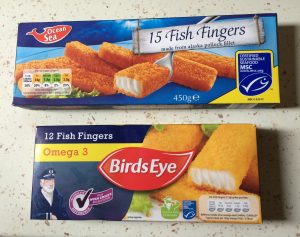
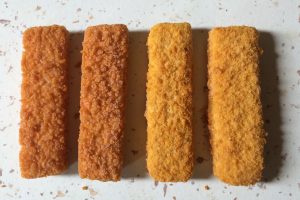
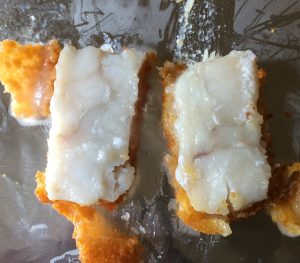
Lidl’s fish finger on the left, Bird’s Eye’s on the right

